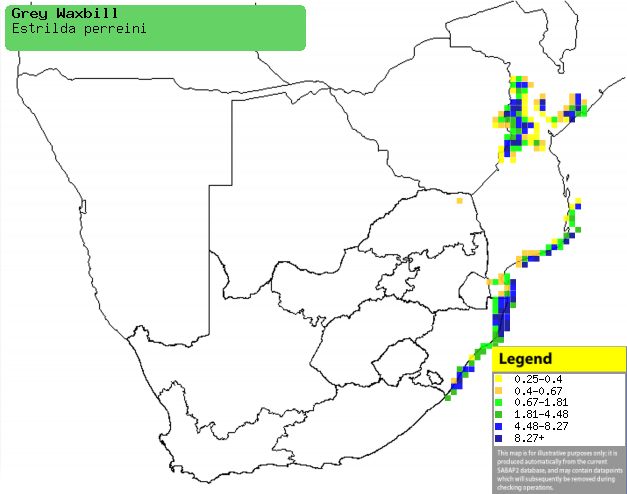|
Estrilda perreini (Grey
waxbill)
Gryssysie [Afrikaans]; Zwartstaartastrild [Dutch]; Astrild
à queue noire [French]; Schwarzschwanz-schönbürzel [German];
Bico-de-lacre-cinzento [Portuguese]
Life
> Eukaryotes >
Opisthokonta
> Metazoa (animals) >
Bilateria >
Deuterostomia > Chordata >
Craniata > Vertebrata (vertebrates) > Gnathostomata (jawed
vertebrates) > Teleostomi (teleost fish) > Osteichthyes (bony fish) > Class:
Sarcopterygii (lobe-finned
fish) > Stegocephalia (terrestrial
vertebrates) > Tetrapoda
(four-legged vertebrates) > Reptiliomorpha > Amniota >
Reptilia (reptiles) >
Romeriida > Diapsida > Archosauromorpha > Archosauria >
Dinosauria
(dinosaurs) > Saurischia > Theropoda (bipedal predatory dinosaurs) >
Coelurosauria > Maniraptora >Aves
(birds) > Order: Passeriformes
> Family: Estrildidae
Distribution and habitat
Occurs from Gabon through Angola and Malawi to southern
Africa, where it is locally common in north-central and southern Mozambique,
extending into eastern Zimbabwe and KwaZulu-Natal. It generally prefers dense
undergrowth along edges of lowland and evergreen forest, coastal bush, sand
forest and thickets.
|
 |
|
Distribution of Grey waxbill in southern Africa,
based on statistical smoothing of the records from first SA Bird Atlas
Project (©
Animal Demography unit, University of
Cape Town; smoothing by Birgit Erni and Francesca Little). Colours range
from dark blue (most common) through to yellow (least common).
See here for the latest distribution
from the SABAP2. |
Food
It mainly eats seeds supplemented with insects and nectar,
doing most of its foraging on the ground and in vegetation, plucking seeds
directly from plants. The following food items have been recorded
in its diet:
- Plants
- seeds
- grass
- Panicum maximum (Guinea grass)
- Casuarina equisetifolia (Horsetail tree)
- Sclerocarya birrea (Marula)
- Insects
Breeding
- The nest is built by both sexes, consisting of an oval-shaped structure
made of grass stems, which protrude outward to form a side entrance; the
interior is lined with grass inflorescences (including Melinis). It
is typically placed in a shrub or small tree, although instead of building
its own it may use an abandoned weaver's nest, such as
Dark-backed,
Spectacled and
Village weavers.
- Egg-laying season is from about March-April in Zimbabwe and from
October-February in KwaZulu-Natal.
- It lays 2-5 eggs, which are incubated by both sexes for about 12 days
(recorded in captivity).
- The chicks are brooded for the first week or so of their lives, leaving
the nest at about 19-21 days (recorded in captivity) and becoming fully
independent about a week later.
Threats
Not threatened.
References
-
Hockey PAR, Dean WRJ and Ryan PG 2005. Roberts
- Birds of southern Africa, VIIth ed. The Trustees of the John Voelcker
Bird Book Fund, Cape Town.
|
